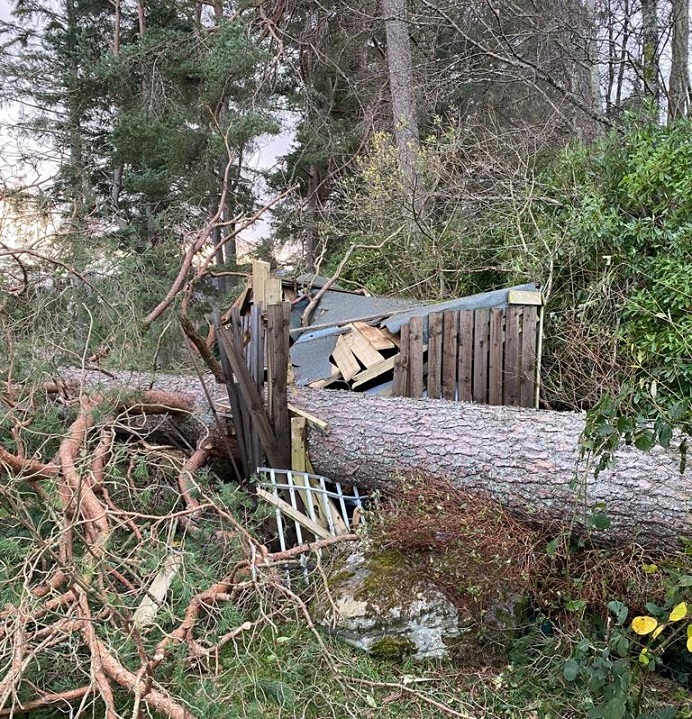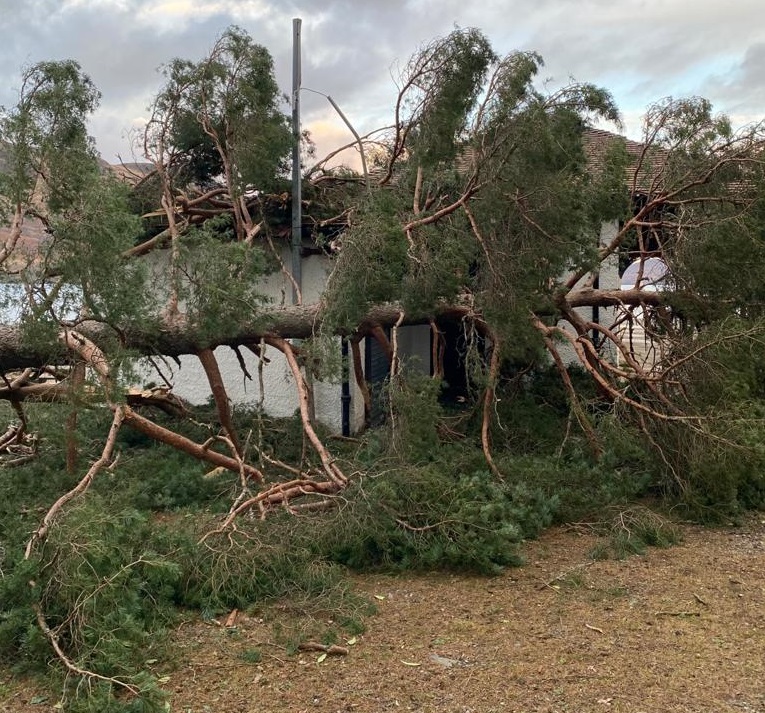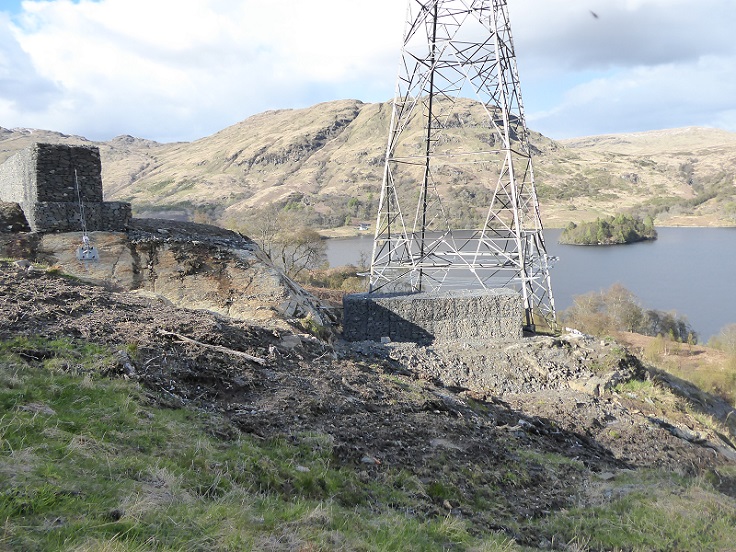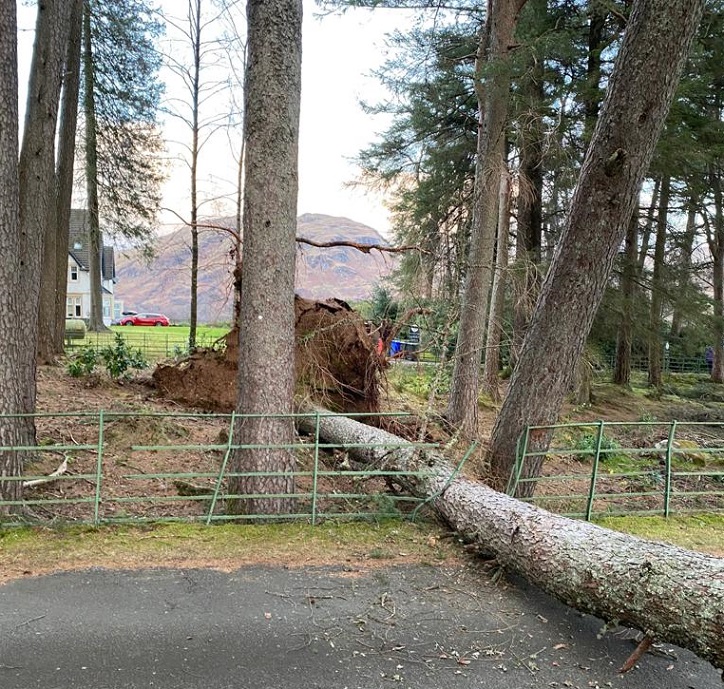
While working on my last post criticising the response of the leadership of the Loch Lomond and Trossachs National Park Authority to the climate emergency (see here), I had no idea of the damage that had by wrought by Storm Arwen at Stronachlachar in the Trossachs. My thanks to the Steamship Trust for including parkswatch in an email to the LLTNPA and others showing the damage.
Storm Arwen was preceded by a hitherto rare red, “danger to life”, weather warning from the Met Office. It came from the north and was predicted to impact most on the east coast. While a lay person might have anticipated strong north winds would impact on Speyside, which is open to the north and indeed where lots of roads were blocked by fallen trees, Loch Katrine is in the lee of fold after fold of hills.
While wind flows over and around mountains in extraordinary ways, which you will know if you have been lifted off your feet on the north east side of Ben Nevis in a south westerly, it would take a far greater expert than I to explain why a place like Stronachlachar was so hard hit by Storm Arwen.

The email stated that twenty large trees have been blown over and people were trapped in nearby properties.

While the damage could have been worse, significant repairs will be needed to the pier cafe and other structures, while the Steamship Sir Walter Scott Trust was due to start work on improving the car park at Stronachlachar Pier on Monday. That work, funded by the Rural Tourism Infrastructure Fund and part of green recovery “post-Covid”, will now be delayed and extra costs incurred.
The damage follows the extreme rain event in August 2019 which caused extensive landslips around Glen Falloch and Loch Katrine (see here) and (here), including no less than twenty-one along the road round the north shore. One of those landslips came close to killing the occupants of one of the houses there. The road was then closed for almost two years while it was cleared, houses excavated, a bent pylon replaced and slopes stabilised.

The landslips had serious financial consequences for the Steamship Trust because a significant part of their income came from people wanting to walk or bike along the north shore of Loch Katrine, who used the Steamship Trust’s facilities, including the Steamship to get to or from Stronachlachar. Now this.
The costs of extreme weather events are not the only financial challenge the Steamship Trust has had to face. Like other businesses it has had to cope with Covid, while just before that in January 2020 cracks were discovered in the steamship boiler putting it out of commission. While all businesses sometimes face unexpected challenges, in the case of the Steamship Trust extreme weather events combined with the impact that several centuries of overgrazing has had on the stability of slopes round Loch Katrine have made a challenging situation even more difficult.

The evidence from the recent storm at Stronachlachar adds to my argument that it is time that the LLTNPA stopped thinking only about itself as an organisation and focussed instead on what it can do to prevent or mitigate the human induced “natural” disasters in the National Park. As part of this it should consider how it might better use its resources to support people’s livelihoods. The involvement of private capital as a solution to the climate emergency, which is being promoted by LLTNPA convener James Stuart, will only make matters worse. The last thing rural businesses need is to be saddled with more debt. Debt is what pushes over organisations like the Steamship Trust when disasters happen. What we need is increased public investment.
I am not arguing here that the LLTNPA should directly support the Steamship Trust, though help from the Ranger Service with the clear-up might be welcome. The Steamship Trust are a resourceful organisation with good contacts and I am optimistic they will pull through despite all the setbacks. (But the LLTNPA could at least stop making life even more difficult for them as they did with the Roderick Dhu footpath planning application (see here).
In the years ahead, however, we are going to see lots more organisations and people in the rural areas of the National Park affected by extreme weather events made worse by the degradation of the natural environment. Until the LLTNPA actually starts to do something meaningful to mitigate those impacts, I believe it has a moral duty to help those communities. Perhaps rather than installing heat pumps and solar panels for its own buildings, it would be better using government funding to do the same in businesses which are on the brink due to the impact of extreme weather events and its own failures to change how land in the National Park is managed?
Obtaining a permit to cut down a mature tree in too many local authority areas has now become a “planning process”. Even the actual person who – without needing permission -planted that selfsame tree 50 years before may not interfere with it in many communities. The permit process is ‘facilitated’ (if that is in any way a correct term?) too often by those stuck in offices, who possibly possess the very least understanding of woodland management . ( Too often today tree preservation orders are slapped in place, to preserve a local view or community ambiance, Instead of a simple acceptance everywhere that essential works recommended by by professional foresters are to happen. Conserving any permanent Plantation remains a simple and periodic land management matter.
I have little doubt that had anyone attempted this past year or so to “interfere” with the mature trees now shown to have fallen by Loch Katrine, there would have been a huge public outcry. Possibly some dafter protesters would then have climbed into the branches to delay remedial work by tree surgeons. We see this far too often now. Yet, while none of us wish to see landscapes alter too much within our lifetimes, the lifespan of tree species is well known. The process of land management must be permitted to occur without so much official disruption. For public safety reasons tree management includes the routine felling, but also replanting and under-planting of broad leaf trees in parklands…so when any older tree reaches full maturity it can be brought down safely without fuss, is common sense. Done in a timely way, any gap left afterwards must be far less obvious. Everyone must Think and plan for the longer term.
I think its important to distinguish a number of very different scenarios when it comes to tree felling: there is tree felling for woodland management (& re S’s comments I am not sure who is said to be against that), tree felling for development and then felling of individual trees. One reason the felling licensing is so important is that developers do try and chop down woodland and then because its gone put in planning applications (I have now covered three examples on parkswatch from around Loch Lomond, Drumkinnon Bay, Tarbet (linked to an planning enforcement case that is still going on) and just north of Inverarnan. As for individual trees, those don’t require felling licenses which is why they are sometimes protected by TPOs or through being in conservation areas. My own urban experience of living in a conservation area is that the planning authority has been extremely reasonable when it comes to trees, for example allowing a large tree that was close to our house to be replaced by a smaller one. In my experience most objections to tree felling occur when the felling is associated with a controversial development eg Flamingo Land or ancient woodland
But hold on a minute management is a bad word according to some.
On a personal note we have managed our woodland, funnily enough after consultation with those terrible souls at FLS cause of the amounts of timber involved. If it had been left 40-50% would have been straight to pulp or biomass as windblown timber is knackered. What is more we would not need a felling license for the windblown timber or even been required to replant it.
And that is before the cost,disruption,hazard to life if it had not been harvested.
I think things are clearly very different in urban Scotland from the author.
Think rural dwellers are generally well equipped and strangely enough have a resilience bourne of environment.
PS the wind issue is caused by a phenomenon called wave, look it up.
There’s no evidence that LLTNPA Convener James Stewart has any interest in the practical value that the LLTNPA might deliver to the community. He appears to be only interested when his involvement is furthering his Darlington consultancy in England, where he and his family live. All theory and no practice.
No offence to your good self…but that is the trouble with these dualistic metaphors that oppose theory and practice. I suggest they are well and truly coordinated in favour of Mr Stewart laughing all the way to the bank.